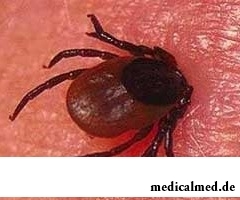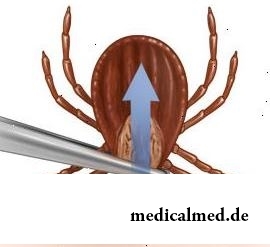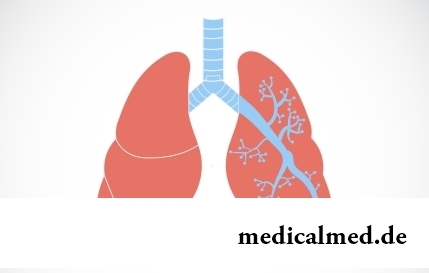





First aid at a sting of a tick
 Danger of mites consists that these blood-sicking insects are carriers of a set of infections, and both bacterial, and virus among which hemorrhagic fevers, encephalitis and borreliosis are the most dangerous.
Danger of mites consists that these blood-sicking insects are carriers of a set of infections, and both bacterial, and virus among which hemorrhagic fevers, encephalitis and borreliosis are the most dangerous.
The traditional habital of mites – the woody area, the greatest activity is noted in warm season, approximately from the middle of spring to the middle of summer. During this period it is necessary to be especially attentive, visiting the wood – it is the best of all to put on the closed clothes at the same time.
If nevertheless trouble occurred, it is necessary to know how it is correct to give first aid to minimize possible danger. At the same time it is necessary to remember that serious infectious diseases which are transmitted by mites are shown after a sting after a while, and time it can vary in considerable limits – from several days to several weeks. Only when within two months after a sting of a tick no unpleasant symptoms appeared, it is possible to claim that the danger passed.
Measures of first aid at a sting of a tick
The sting of a tick is artful that it often is found not at once as in itself it does not cause any feelings, all troubles begin later. As a rule, the person finds on himself the stuck tick – the sting can last of 15 minutes till several o'clock.
 The first that needs to be made, it to take a tick. It is necessary to do it very carefully, trying not to crush an insect as in this case danger of infection repeatedly increases. For extraction of a tick it is possible to use the medical tweezers, the special device which is on sale in drugstores or the loop which is independently made of a thread. The insect needs to try to be captured closer to the head, to take slowly, to pull perpendicular to skin, doing at the same time the shaking or slightly rotating (unscrewing) movements. The taken tick needs to be placed in the small glass capacity with water supplied with densely closed cover.
The first that needs to be made, it to take a tick. It is necessary to do it very carefully, trying not to crush an insect as in this case danger of infection repeatedly increases. For extraction of a tick it is possible to use the medical tweezers, the special device which is on sale in drugstores or the loop which is independently made of a thread. The insect needs to try to be captured closer to the head, to take slowly, to pull perpendicular to skin, doing at the same time the shaking or slightly rotating (unscrewing) movements. The taken tick needs to be placed in the small glass capacity with water supplied with densely closed cover.
After an insect it was succeeded to take out completely, the wound is washed out water with soap, then processed an antiseptic agent. If the proboscis of a tick broke off and remained in skin, it should not be picked out, after a while – usually it takes several days – it will leave. The place of a sting is processed also.
Attention! Contrary to quite often described so-called national methods, it is impossible to drip on a tick oil, alcohol or any other liquid, and also to cauterize it it broke breath, and it independently disappeared. In this case the risk of infection as at breath disturbance the insect emits saliva which, quite possibly, contains a huge number of causative organisms in a wound is extremely high.
The sting of a tick, in addition to the most various diseases, can cause quite strong allergic reaction. It is shown in hypostasis in the place of a sting, erubescence, emergence of a skin itch and/or rash. Expressiveness of symptoms varies from insignificant to very heavy, up to a life-threatening Quincke's edema (the hypostasis of upper respiratory tracts leading to breath disturbance). Therefore at the first signs of allergic reaction as a measure of first aid it is necessary to give to the victim antihistaminic drug (Loratadin, Suprastin, Diazolin, Tavegil, etc.).
First aid is given what to do next?
If the region in which there was such case belongs to unsuccessful on an epidemiological situation concerning mites, for example, cases of development of a tick-borne encephalitis or other infectious diseases transferred by them – that right after first-aid treatment are known, it is necessary to carry the taken insect in laboratory on the analysis. Addresses of laboratories in the territory of Russia can be learned in Rospotrebnadzor. Usually results of a research are ready on the same day or on following, and depending on them the decision on further actions is made.
It must be kept in mind that viruso-and/or bacillicarriers only a little more than 10% of mites therefore chances that the insect will be sterile, and it will be possible to be limited to measures of first aid are, are rather high. If it is established that the tick supports causative agents of any disease and the more so several, it will be necessary to ask for medical assistance and to undergo vaccination.
If there is no opportunity to carry a tick on the analysis, then it is necessary to watch the state of health of the victim. If inflammation signs on site of a sting disappeared within 1-2 days, the probability of development of any pathology is considered minimum. However if in 2 days in the place of a sting there are a redness and a swelling and the more so if they increase, it is necessary to see a doctor urgently.
Within 10 days after a sting it is necessary to measure and write down body temperature. Temperature increase during this period can indicate the beginning of an infectious disease, in this case it is also necessary to ask for medical care.
Some diseases which carriers are ticks can be shown later rather long time after a sting – so, borreliosis develops 2-3 weeks therefore during this time it is necessary to show vigilance later. At emergence of any deviations in the state of health (weakness, fever, spots on skin, neck muscle tension, a headache, etc.) it is necessary to see a doctor as soon as possible.
Human bones are stronger than concrete four times.

History of cultivation of a buckwheat contains more than five thousand years. Grain which is received from this plant is used for пригото...
Section: Articles about health
A little more than a century ago goat milk was a traditional food stuff of most of Russians. Unfortunately, today on tables of our compatriots it appears extremely seldom. The reason that the use of so useful product practically descended on...
Section: Articles about health
Life does not indulge the modern woman special emotional comfort and carelessness. The fatigue, troubles at work, misunderstanding in a family and various illnesses immediately affect a condition of hair and skin. And there is a wish to look safe and attractive so! Substantially competently picked up diet can improve situation....
Section: Articles about health
According to doctors, more than a half of men of 25-50 years suffer from frustration of the urinogenital sphere, but sees a doctor from them меньшинс...
Section: Articles about health
According to World Health Organization, every third inhabitant of Earth has excess weight, and every tenth has obesity. The reason of this phenomenon, according to specialists, roots in one not very comforting fact: most of people consume much...
Section: Articles about health
They say that to ensure health and longevity of people it is obliged. Really, at competent approach to these questions, minimization of an adverse effect of many factors does not represent a special problem. Practically everyone has an opportunity to play sports, to pick up an optimum operating mode and rest, to adjust healthy food, to refuse addictions. It is more difficult to exclude hit in an organism of harmful substances through a respiratory organs: not all are able to afford to live in the area with хо...
Section: Articles about health
Cystitis, or inflammation of a mucous membrane of a bladder, this very widespread disease, which, owing to some persons...
Section: Articles about health
Partial and the more so full loss of hearing significantly reduces quality of life. Difficulties with communication lead to loneliness and isolation. The person who badly hears experiences difficulties with social and professional implementation, quite often has problems in...
Section: Articles about health
Coffee - the tonic loved by many for the invigorating aroma and deep taste. Having the stimulating effect, coffee increases working capacity, promotes concentration of attention, fights against drowsiness and improves mood. Statistically, about 30% of inhabitants of the planet regularly use coffee, from them more than 8% are "coffee-achievers" - the persons using more than 3 cups of drink a day....
Section: Articles about health
Water with a lemon - idle time in preparation drink which supporters of a healthy lifestyle already managed to appreciate. Upo...
Section: Articles about health
Antibiotics - - it is possible to call the chemical compounds suppressing growth of bacteria the break in the field of medicine which allowed to save mankind from many diseases incurable earlier: tuberculosis, plague, syphilis and many others. A contribution of drugs to rescue of people from...
Section: Articles about health
Statistically, pathologies of a thyroid gland in the world more than 500 million people have. Failures in work of this body lead to heavy disbolism, development of heart diseases, vessels, a reproductive and nervous system. In hard cases excess or insufficient production of the main hormones of a thyroid gland (thyroxine and triiodothyronine) leads to essential decline in quality of life and disability....
Section: Articles about health
History of use of an anesthesia during operations contains more than 160 years. Annually in the world hundreds of thousands surgical вм are carried out...
Section: Articles about health
Practically each person is familiar with the annoying, pulling, unscrewing pains caused by overcooling of muscles of a back. In certain cases inflammatory process is not limited to discomfort, being followed by emergence of hypostasis, consolidations, increase температ...
Section: Articles about health
The popular expression "run from a heart attack" became the motto of the people supporting active lifestyle. Moreover, run became a peculiar fashionable tendency: sales of racetracks and the accompanying goods for run are at permanently high level. Whether really it is possible for one and all people and it is necessary to run to receive the portion of health, a charge of cheerfulness and good mood?...
Section: Articles about health
Doctors claim that the people not so familiar with a dorsodynia occur among adult Russians very seldom. At the same time подавляющ...
Section: Articles about health
The drugs stopping or oppressing life activity of pathogenic microorganisms are widely applied in clinical practice from 40th years of the last century. Originally antibiotics were called only substances natural (animal, vegetable or микробног...
Section: Articles about health
The cosmetics intended for improvement of a condition of skin, nails and hair are used by each woman. Expenses on regular acquisition of the fashionable widely advertized products of well-known companies for many become very notable and significantly burden the family budget. Meanwhile, there is a number of inexpensive pharmaceutical drugs which can quite be applied in the cosmetic purposes. At the same time the effect of their use is often more noticeable, than result of use of the most expensive...
Section: Articles about health
Bulimia and anorexia, are heavy deviations of a feeding behavior, become a cause of death of patients much more often than all others...
Section: Articles about health
The kid who was recently born is surrounded with love of adult family members and their cares without which the baby cannot exist. Some parents consider that gentle attachment and caress are quite enough that the child correctly developed and was happy...
Section: Articles about health
The varicosity has familiarly many, statistically, this disease more than a half of all adult population. As a rule, the varicosis affects preferential superficial vessels, and is shown by characteristic cosmetic defects. The deep vein thrombosis as this illness at the initial stages can imperceptibly proceed is represented much more dangerous, and in the started cases threatens with serious danger – thrombosis. This state, when the blood clot formed...
Section: Articles about health
With age in a human body harmful substances collect. We receive them with food and water, at inhalation contaminated air...
Section: Articles about health
Hemorrhoids – extremely widespread disease. Periodically arising inflammations and bleeding of hemorrhoidal nodes cause serious discomfort to nearly fifteen percent of adults. Meanwhile, having a clear idea of the aggravation reasons...
Section: Articles about health
For many spouses the question of planning of a family is one of the main. The problem of the choice of effective and safe contraceptives at the same time comes out on top. Russians still not often resort to operation of a vasectomy extremely popular in the USA, and also in some European and Asian countries. The reason is simple: most of men simply do not possess the complete information about specifics and effects of this procedure. Let's try to meet this lack and to acquaint readers about those...
Section: Articles about health
The majority of gynecologic diseases prove three main signs, each of which speaks about need to the visa...
Section: Articles about health
The thought that the mass of their body is too big at least once in life visits from 80 to 95% of women. Many women are so obsessed with this idea that constantly try all new and new ways of weight reduction. Considerable part of these method...
Section: Articles about health
For most of the working people the problem of having a snack is particularly acute enough. Sooner or later there is a question: what can be eaten quickly between a breakfast and a lunch or a lunch and leaving from service so that to receive necessary power feed, but not to overload an organism with harmful components or excess calories? We bring to your attention the list of products which quite conform to these requirements....
Section: Articles about health
